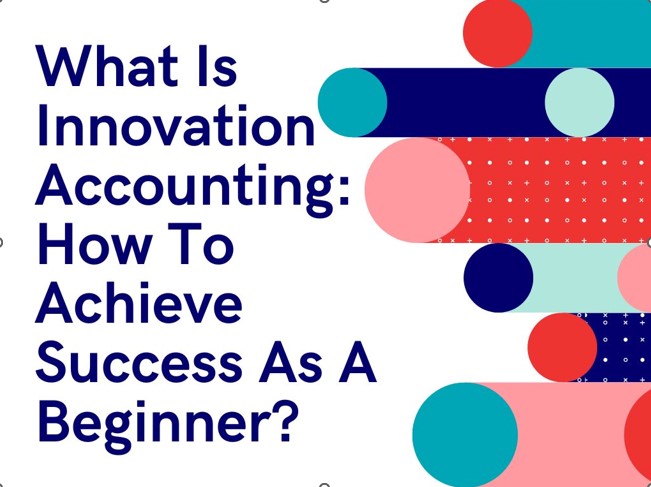How To Know If Someone Blocked You On iMessage? 5 Secret Hacks!
Apr 16, 2025

Apr 16, 2025

Apr 16, 2025

Apr 15, 2025

Apr 11, 2025

Apr 11, 2025

Apr 11, 2025

Apr 08, 2025

Mar 29, 2025
Sorry, but nothing matched your search "". Please try again with some different keywords.


What is innovation accounting? It means figuring out how to measure the impact of innovation efforts in a way that lets entrepreneurs and organizations make smart decisions about how to use their resources.
Innovation accounting is a way to measure progress when all the usual metrics used by an established company (revenue, customers, return on investment, and market share) are close to zero.
Entrepreneurs and organizations should keep track of these metrics over time. In that case, they can find trends and patterns to help them make better decisions about their projects. You just have to find the best innovation consulting that suits all your needs for your business or organization.
It also helps entrepreneurs and businesses generate fresh ideas in a fast-changing world. This allows them to manage innovation projects and make data-driven decisions to make innovative designs for the market better.
Here are the three elements of innovation accounting.
Investments require quantitative research, and this is one of the most important elements of innovation accounting. These numerical data help the innovation leaders pick between two industry projects by focusing on clients’ basic demands and wants and employing a precise and specialized strategy.
If two parties disagree qualitatively on an innovative issue. In that instance, quantitative measurements can help identify the best and easiest solution for the organization.
Innovation accounting must do more than give organizations relevant numbers. It must also show a level of transparency and accountability in areas that are unclear and new to innovation teams.
One of the main things it looks at is how users to act. Hence, it confirms the necessary information about how the business will grow and what will happen in the next few years.
Innovation accounting includes information like the number of site visitors and new users in a given period.
Innovation accounting must look at the organization’s projects from a clear but broad point of view. It should examine whether the business has all the knowledge, skills, and resources it needs to carry out new ideas that align with its strategy.
It is essential to learn about these things, especially when figuring out what drives innovation in an organization and how it affects business entities.
Innovation accounting also includes information about relevant skills that can help improve innovation performance. Some examples are management, technical knowledge, skills for working with people, design, and digital skills.
The key is that lean startup accounting and its metrics are not fixed. The Build-Measure-Learn cycle is at the heart of the lean startup process. Not only is the product always getting better, but every time it is tested or used, new information is gathered.
This gives the process a sense of movement since the data given by the metrics changes to reflect the most recent information.
You can see right away what each new piece of data means for your business. The three dashboards give you an updated picture of how your product came to be and how it got to market.
Here are the advantages of using innovation accounting.
The key is to start with metrics that are easy to track and related to activities that are part of making a digital product. Since the whole point of lean startup is to understand and meet users’ needs, Ries suggests putting the customer first for this first level.
Innovation accounting starts with a small set of metrics that are easy to understand and can be used in the organization’s digital product development process.
The questions involved on this level are:
The goal is to ensure the development process is closely tied to what users want and how they feel about it. Metrics like these show how involved your users are in developing your product.
Creating products in fields you don’t know much about or even in industries you’re not an expert in is a leap of faith because you must use assumptions to build new things. The second level of innovation accounting is about measuring and evaluating these assumptions.
The lean startup accounting method assumes you can only start building something new by making at least one or two assumptions. The second level of innovation accounting metrics measures how valid those assumptions are.
There are two kinds of leap-of-faith assumptions: the value users will get from the product and how new users will find your product.
The value metrics that Ries suggests are meant to look for good user behavior.
While the recommended growth metrics look for signs of growth that will last.
In a business plan, an entrepreneur may want to reach a certain value within a certain amount of time. Yet, the net present value of innovation, or NPV, shows how valuable it is right now.
The NPV looks at things that affect the value and performance of products and services in the future, such as:
This level is also used to find out how well the product or service does financially. It shows how innovation works over time using a set of success metrics and data from the present.
These are the three main activities of innovation accounting:
Choose measurements that are easy to understand. You can start by choosing one or more of the indicators on the first level of innovation accounting.
But you can also ask yourself the questions below and use the answers to come up with useful metrics.
Use the progress and success indicators you chose for the three levels of innovation accounting shown above. Get the right information, keep an eye on the right processes, and look at the progress.
Find out how your data can help you be more innovative. Work on it and plan every step. Find out how far you’ve come and where the project is going.
Find out if product development is in line with what users want and what changes need to be made to make customers happier.
Innovation accounting tracks and manages innovative projects. It helps track essential metrics and indicators that affect the performance of a creative project and uses that data to guide its development.
Innovation accounting helps firms make better data-driven decisions about which projects to invest in, pivot toward, or abandon. Organizations can spot problems early and fix them by recording and analyzing the right metrics.
Its main goal is to help companies innovate and succeed. Data-driven decisions about innovation projects can help firms achieve and foster a culture of innovation and development.
Read Also:
Abdul Aziz Mondol is a professional blogger who is having a colossal interest in writing blogs and other jones of calligraphies. In terms of his professional commitments, he loves to share content related to business, finance, technology, and the gaming niche.
View all Posts
How To Know If Someone Blocked You On iMessag...
Apr 16, 2025
7 Website Design Mistakes That Are Hurting Yo...
Apr 16, 2025
Programmable Dynamic SEO for Location-Based P...
Apr 15, 2025
Google Boba Game: How To Play This Fun Game B...
Apr 11, 2025
Which Is The Best Video Search Engine Of 2025...
Apr 11, 2025

